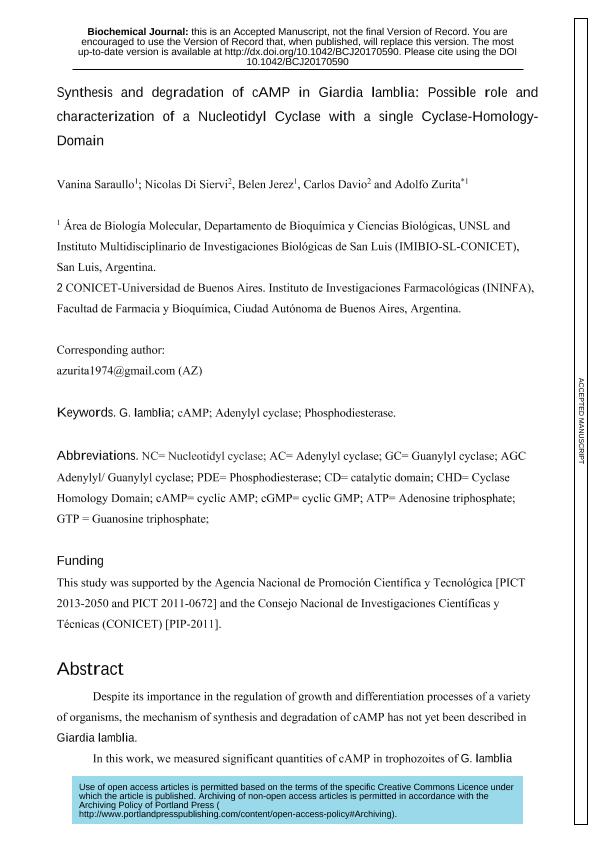Mostrar el registro sencillo del ítem
dc.contributor.author
Saraullo, Vanina Rosa

dc.contributor.author
Di Siervi, Nicolás

dc.contributor.author
Jeréz, María Belén

dc.contributor.author
Davio, Carlos Alberto

dc.contributor.author
Zurita, Adolfo Ramón

dc.date.available
2018-06-04T16:53:03Z
dc.date.issued
2017-12
dc.identifier.citation
Saraullo, Vanina Rosa; Di Siervi, Nicolás; Jeréz, María Belén; Davio, Carlos Alberto; Zurita, Adolfo Ramón; Synthesis and degradation of cAMP in Giardia lamblia: Possible role and characterization of a nucleotidyl cyclase with a single cyclase homology domain; Portland Press; Biochemical Journal; 474; 23; 12-2017; 4001-4017
dc.identifier.issn
0264-6021
dc.identifier.uri
http://hdl.handle.net/11336/47143
dc.description.abstract
Despite its importance in the regulation of growth and differentiation processes of a variety of organisms, the mechanism of synthesis and degradation of cAMP (cyclic AMP) has not yet been described in Giardia lamblia. In this work, we measured significant quantities of cAMP in trophozoites of G. lamblia incubated in vitro and later detected how it increases during the first hours of encystation, and how it then returns to basal levels at 24 h. Through an analysis of the genome of G. lamblia, we found sequences of three putative enzymes - one phosphodiesterase (gPDE) and two nucleotidyl cyclases (gNC1 and gNC2) - that should be responsible for the regulation of cAMP in G. lamblia. Later, an RT-PCR assay confirmed that these three genes are expressed in trophozoites. The bioinformatic analysis indicated that gPDE is a transmembrane protein of 154 kDa, with a single catalytic domain in the C-terminal end; gNC1 is predicted to be a transmembrane protein of 74 kDa, with only one class III cyclase homology domain (CHD) at the C-terminal end; and gNC2 should be a transmembrane protein of 246 kDa, with two class III CHDs. Finally, we cloned and enriched the catalytic domain of gNC1 (gNC1cd) from bacteria. After that, we confirmed that gNC1cd has adenylyl cyclase (AC) activity. This enzymatic activity depends on the presence of Mn2+ and Ca2+, but no significant activity was displayed in the presence of Mg2+. Additionally, the AC activity of gNC1cd is competitively inhibited with GTP, so it is highly possible that gNC1 has guanylyl cyclase activity as well.
dc.format
application/pdf
dc.language.iso
eng
dc.publisher
Portland Press

dc.rights
info:eu-repo/semantics/openAccess
dc.rights.uri
https://creativecommons.org/licenses/by-nc-sa/2.5/ar/
dc.subject
Camp
dc.subject
Giardia Lamblia
dc.subject
Nucleotidyl Cyclase
dc.subject
Phosphodiesterase
dc.subject.classification
Inmunología

dc.subject.classification
Medicina Básica

dc.subject.classification
CIENCIAS MÉDICAS Y DE LA SALUD

dc.title
Synthesis and degradation of cAMP in Giardia lamblia: Possible role and characterization of a nucleotidyl cyclase with a single cyclase homology domain
dc.type
info:eu-repo/semantics/article
dc.type
info:ar-repo/semantics/artículo
dc.type
info:eu-repo/semantics/publishedVersion
dc.date.updated
2018-06-01T19:22:30Z
dc.journal.volume
474
dc.journal.number
23
dc.journal.pagination
4001-4017
dc.journal.pais
Reino Unido

dc.journal.ciudad
Londres
dc.description.fil
Fil: Saraullo, Vanina Rosa. Consejo Nacional de Investigaciones Científicas y Técnicas. Centro Científico Tecnológico Conicet - San Luis. Instituto Multidisciplinario de Investigaciones Biológicas de San Luis. Universidad Nacional de San Luis. Facultad de Ciencias Físico Matemáticas y Naturales. Instituto Multidisciplinario de Investigaciones Biológicas de San Luis; Argentina
dc.description.fil
Fil: Di Siervi, Nicolás. Consejo Nacional de Investigaciones Científicas y Técnicas. Oficina de Coordinación Administrativa Houssay. Instituto de Investigaciones Farmacológicas. Universidad de Buenos Aires. Facultad de Farmacia y Bioquímica. Instituto de Investigaciones Farmacológicas; Argentina
dc.description.fil
Fil: Jeréz, María Belén. Consejo Nacional de Investigaciones Científicas y Técnicas. Centro Científico Tecnológico Conicet - San Luis. Instituto Multidisciplinario de Investigaciones Biológicas de San Luis. Universidad Nacional de San Luis. Facultad de Ciencias Físico Matemáticas y Naturales. Instituto Multidisciplinario de Investigaciones Biológicas de San Luis; Argentina
dc.description.fil
Fil: Davio, Carlos Alberto. Consejo Nacional de Investigaciones Científicas y Técnicas. Oficina de Coordinación Administrativa Houssay. Instituto de Investigaciones Farmacológicas. Universidad de Buenos Aires. Facultad de Farmacia y Bioquímica. Instituto de Investigaciones Farmacológicas; Argentina
dc.description.fil
Fil: Zurita, Adolfo Ramón. Consejo Nacional de Investigaciones Científicas y Técnicas. Centro Científico Tecnológico Conicet - San Luis. Instituto Multidisciplinario de Investigaciones Biológicas de San Luis. Universidad Nacional de San Luis. Facultad de Ciencias Físico Matemáticas y Naturales. Instituto Multidisciplinario de Investigaciones Biológicas de San Luis; Argentina
dc.journal.title
Biochemical Journal

dc.relation.alternativeid
info:eu-repo/semantics/altIdentifier/doi/http://dx.doi.org/10.1042/BCJ20170590
dc.relation.alternativeid
info:eu-repo/semantics/altIdentifier/url/http://www.biochemj.org/content/474/23/4001
Archivos asociados
